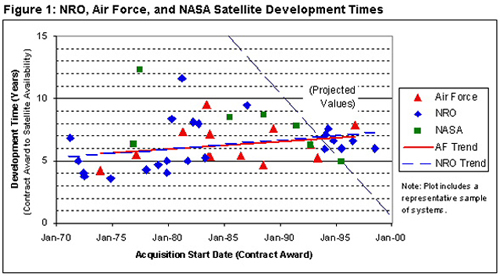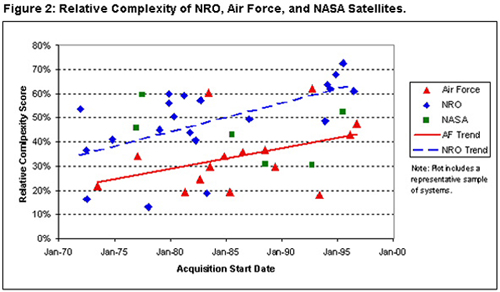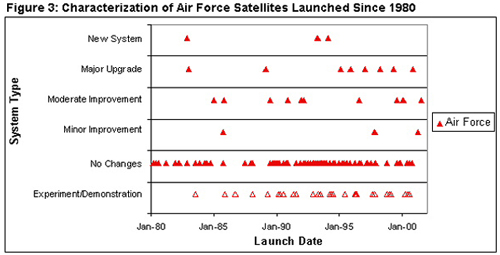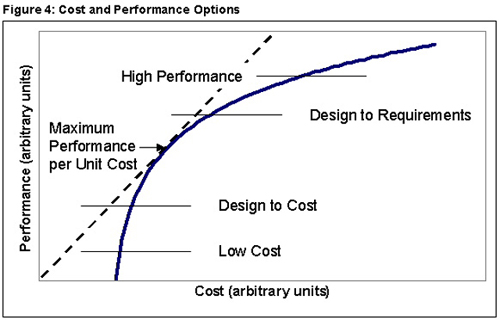 |
 |
  |
Appendix FNRO Acquisition StrengthsBackgroundThe statute that established the Commission directed, among other tasks, a review of NRO roles and missions. One of the foremost of NRO's roles and missions is research, development and acquisition (RD&A) of satellites. As part of its work, the Commission conducted a study to better understand these issues by drawing comparisons between the NRO and other U.S. Government organizations that conduct RD&A of satellites 1 : the U.S. Air Force and NASA. The Commission's study posed three questions:
The answers to these questions are closely related to the other Commission findings and judgments included in the Commission Report. In particular, the NRO's strengths as a builder of satellites are highly relevant to issues involving the scope of the NRO mission and the extent to which the NRO should be involved in developing technology solutions for tasking, processing, exploitation, and dissemination. NRO strengths and the sources of those strengths are also pertinent to the question of how best to prepare NRO for the future, as discussed starting on of the Report. In this Report, the Commission determined that actions must be taken to enable the NRO to engage in the most advanced RD&A efforts so that it will be able to place the most advanced reconnaissance satellites in orbit. This finding is partly based on a study finding that the NRO has excelled in engineering creativity and has consistently sought and delivered high performance in its satellites. The study took account of all major NRO programs since the 1960's, encompassing imagery intelligence (IMINT), signals intelligence (SIGINT), and communications satellites. The analysis also examined Air Force programs since the 1960's, comprising satellite programs for weather, infrared missile warning, navigation (Global Positioning System), and military communications. Commission analysts initially examined a subset of NASA programs, limited to unmanned, earth-orbiting satellites, also going back to the 1960's. NRO, Air Force and NASA programs were compared in terms of cost, schedule and performance, including factors such as complexity of the satellite systems and the extent of technological innovation. The data to support a comparison of NRO with Air Force and NASA were limited largely because of inconsistent methods for tracking and retaining information within the three organizations. It was recognized early on in the analysis that any comparison would be subject to several significant caveats and qualifications. Chief among these was that NRO, Air Force and NASA satellite RD&A efforts might not be subject to comparison because of the wide differences between the missions of the three organizations. The differences between, for example, Air Force navigation satellites, NRO imagery satellites, and NASA weather satellites might be so fundamental that RD&A comparisons would not be feasible. Nonetheless, historically some have judged the NRO as being "better" than the others. The Packard Commission on DoD acquisition reform completed in the mid-1980's is one of the most notable examples. In any case, the Commission found it useful instead to pursue the comparison in order to determine and identify NRO strengths. Key FindingsCost, Schedule and Performance. The point of departure for the study was to compare NRO, Air Force and NASA RD&A efforts for cost, schedule and system performance efforts, the traditional measures of RD&A performance. In this regard, the Commission study resulted in three basic finding:
With regard to this last point, the finding was derived from the study's effort to compare the NRO to Air Force for system performance, inasmuch as system performance is one of the dimensions of an organization's overall acquisition performance. However, there is no comprehensive measure of satellite performance that allows comparison between satellites built to accomplish widely different missions. To remedy this, the Commission used a proxy measure for performance: satellite complexity. The unclassified results for the relative complexity of (a subset of) NRO, Air Force and NASA satellites are shown in Figure 2. Thus, while NRO and Air Force satellites take comparable times to develop, NRO satellites are both more costly and more complex. By themselves, however, these findings do not answer the question concerning NRO's strengths. In particular, why has the NRO developed more complex satellites? Factors relating to greater NRO complexity. In examining factors that might account for the greater complexity of NRO satellites, the study focused on pressures from external stakeholders, funding differences, and differences in organization. Using historical data, the study found that, relative to the Air Force, the NRO has been subject to more pressure from the U.S. national security and intelligence communities to develop new satellites. Much of this pressure was related to the imperative to collect intelligence about Soviet weapons developments where satellite-derived IMINT and SIGINT represented the best or, in some cases, the only option for the United States. In contrast, although the Air Force was subject to pressures in the 1960s for new systems and subsequent influences to improve its satellites, the pressures were less than those placed on the NRO. A further factor in the greater complexity of NRO satellites is differences in funding levels. By examining appropriated funds since 1967, Commission analysts found the NRO has been consistently funded at levels significantly greater than the Air Force for development and operation of satellites and their related ground systems. More funding provides greater opportunities for more research, leading in turn to more complex developments. Finally, based largely on its historical classified status, the NRO was able to create and maintain certain organizational features that contributed to innovation. The NRO, unlike the Air Force, was able to organize the conduct of both RD&A within the same organization, in a cohesive way. In addition, the historically classified status of the NRO allowed it a great measure of discretion in using appropriated funds because they were contained in relatively few accounts. The NRO was also relatively insulated from the type of yearly budget turbulence encountered by the Air Force across its many space and non-space programs. Thus, the greater complexity of NRO satellites can be traced to: greater external pressure for performance improvements (in new systems); a much higher and consistent level of funding; and a more cohesive and insulated approach to RD&A. It is worth noting that all three of these factors supporting satellite complexity derive from the NRO mission to build and operate classified satellite reconnaissance systems. Additional factors characterizing the NRO's Approach. With a better understanding of the sources of NRO satellite complexity, the Commission analysis sought deeper insight into how the NRO and the Air Force approaches differed. To this end, NRO and Air Force program offices provided data regarding whether their satellites were new systems, major upgrades, moderate improvements, minor improvements, unchanged (clones), or experiments or demonstrations. The Air Force satellites in this comparison are shown in Figure 3. While the NRO part of this comparison is classified, it can be stated that the NRO satellites populate the upper third of the Figure to a much greater extent than the Air Force satellites. The review indicated that the NRO has undertaken more new systems and more major upgrades, and the Air Force has pursued more moderate or minor upgrades or clones . In addition to initiating more new starts and major and moderate upgrades to satellites than the Air Force, the NRO has had more distinct variants of systems since the 1960s. To understand these data, analysts examined the sources of requirements for satellite development. One finding, previously stated, was that the NRO has had more pressure from external users for new systems. Howev er, when looking at the sources or requirements for upgrades, the study found less evidence for pressures from users. Based on interview data, analysts found that the origin of upgrades to NRO satellite performance was not based on approved user requirements as much as on NRO engineers pursuing, with industry, the "art of the possible" in technology based on broadly defined Intelligence Community problems. This "enabled creativity" of the NRO-industry partnership provided the engine for NRO's high tempo of major and moderate upgrades to systems, resulting in a series of successive, incremental--though often significant--improvements in performance. In contrast, the Air Force had to operate within original requirements for systems, and introduced new systems and upgrades within a more rigid framework of approved user requirements and carefully controlled funds appropriated for very specific purposes. Another relevant factor was the extent to which the NRO and Air Force were able to take advantage of technological heritage, i.e., useful technology from prior systems, in RD&A of new systems and upgrades. Air Force satellite programs have had a high degree of heritage, with many clones and incremental improvements. The first new, low-heritage Air Force system in decades, MILSTAR I and II, was more costly then expected. The NRO has introduced a larger number of new, low heritage systems, with many successes and a few programs with overruns and schedule slippages. However, most NRO systems and new systems or upgrades have tended to take advantage of a moderate to high degree of heritage from previous systems. This does not mean that these NRO systems were inexpensive. Rather, NRO's approach to RD&A often benefited from a moderate to high heritage with prior systems and significant funding for upgrades. NRO's "comparative advantage." The study found that part of the "comparative advantage" of the NRO relative to the Air Force is that the NRO has been able to pursue "technological depth" within a relatively focused, space reconnaissance-related set of problems, with high heritage for many important initiatives. The NRO relatively narrow focus allowed it to pursue technological solutions in depth. High levels of funding, an ability to transfer money quickly between programs and a cohesive approach to RD&A, provided the NRO the flexibility to produce more complex systems. NRO's high performance approach. The NRO and the Air Force have generally taken different approaches to trading cost versus performance, with NRO taking what can be termed "the performance over cost approach." In terms of the notional trade-offs between performance and cost, shown in Figure 4, small increments in performance come at significantly more cost, shown at the right end of the curve. When plotted on a similar chart, NRO satellites typically demonstrate "a high performance approach" and Air Force satellites demonstrate the "design to requirements" approach. The NRO's focus on high performance is reflected in higher satellite development costs and in the fact that it has made continuous efforts to improve intelligence collection systems. The NRO approach has resulted in advances in the state of the art, both in terms of the targets of intelligence collection, and in terms of higher performance spacecraft. The NRO emphasis on performance was recently cited in a public remark by the Director of the NRO: "We have an outstanding record of delivering capability better than we were asked to do. In the past, NRO program managers were told to err on the side of best performance, rather than cost or schedule." Additional FindingsComplementing the key findings described above, the study produced additional findings that also bear on the question of the strengths of the NRO.
While there is some evidence that NRO and Air Force satellites have comparable costs per pound, the heaviest satellites have been developed by NRO. Analytical JudgmentsDifferent organizational approaches to RD&A. The NRO, the Air Force and NASA have highly different approaches to satellite RD&A. The NRO historically has built "niche" satellites that have relatively specialized missions and users. Further, the NRO has historically been under more external pressure for new system performance. Moreover, it has had a relatively narrow mission focus--IMINT, SIGINT and supporting communications--and very high technology content. The NRO "paradigm" has been a quest for high performance, in response to intelligence needs, with frequent new starts and continual improvements to existing systems. In contrast, the Air Force's systems are designed for a wider user base. The Air Force's satellite RD&A activities programs are highly diverse in terms of different satellite missions. Further, its satellite design and performance specifications are more highly tied to formal, approved user requirements. In addition, the Air Force preference is to stabilize design rapidly and move to more serial production, rather than adding improvements for each successive vehicle of a satellite generation. Contrasting to both the NRO and the Air Force, the NASA approach to satellite and spacecraft development maybe best described as "let a thousand flowers bloom" within a budget historically that has been larger than that for NRO and Air Force space programs combined. NASA programs are extremely diverse, more so than those of the Air Force. NASA programs have very high technology content, like the NRO. With the exception of weather satellites, NASA satellites and spacecraft are virtually all "one-of-a-kind" or "few of a kind," requiring extensive R&D. Overall, the engineering creativity and quest for performance demonstrated in NRO programs applies equally well to many NASA programs. NRO strengths. The NRO has certain strengths:
Sources of NRO strengths. The Commission study found four sources for the NRO's strengths:
Changes in sources of NRO success. An additional judgment is that some of the conditions that produced historical NRO success relative to the Air Force are undergoing change. The NRO mission is increasingly wide and the NRO is increasingly tied to wider requirements processes. There has been a shift away from NRO ability to maintain an experienced, long-duration work force. In addition, while NRO acquisition authorities remain unchanged, there has been an erosion in some key features of the NRO approach to RD&A: NRO funding is less insulated and it has less flexibility in use of appropriated funds. ConclusionThe Commission reached three main conclusions: First, the NRO, Air Force and NASA have distinct "organizational cultures" and approaches to satellite RD&A. There is little basis to conclude that one is better than another. The approaches of each are well suited to their differing missions, and the performance of each has generally satisfied the different user communities. Second, relative to the Air Force and NASA, the NRO has some distinct strengths, but there is a balance between strengths and weaknesses. Relative to the Air Force, the NRO has been able to produce more complex satellites, in comparable time, and at comparable costs per pound. In some cases, NRO system upgrades may be less directly tied to approved user requirements, and users have only come to value NRO improvements after the satellite is in operation. Finally, as noted elsewhere in this Commission Report, some of the key sources of NRO successes have evolved in a way that puts some features of the NRO approach at risk. In particular, the NRO has had great successes in developing innovative, "niche" systems, whereas there are greater pressures today for it to focus much more on standardized systems with a very wide customer bases. 1 One of the assumptions made in the study was that the most worthwhile comparison was between satellites and satellites, rather than between satellites and other complex systems, such as aircraft. |
||



